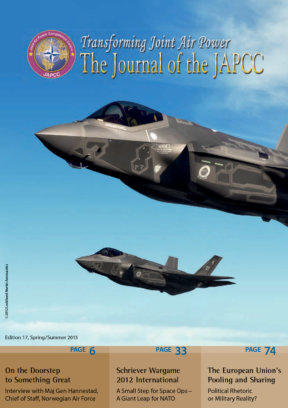Editorial
NATO’s Air Power has been of utmost importance to the Alliance since its inception. Time and time again, NATO and the Alliance nations have turned to Air Power as their first, and in some cases only, military response option. Air Power, now coupled with Space Power, continues to demonstrate its unprecedented value. It provides the widest variety of response options against a range of threats, crises or disasters; to safeguard our populations and enable NATO operations.
Despite its unprecedented value, NATO nations have and continue to drastically reduce their Air Power capabilities. This trend began at the end of the Cold War and continues at an alarmingly increasing rate. The near-term cessation of Afghanistan operations, combined with the on-going financial crisis, makes it certain that Air & Space (A&S) Power capabilities will be under heavy scrutiny and most likely further reduced. Although everybody talks about money, this is not the key problem in NATO. European NATO members collectively spend about € 240 billion annually on defence, second in the world after the United States. The problem is that the money is spent wrongly. The sovereignty paradigm prevents the nations from really making steps forward in multinational cooperation. Smart Defence will never lead to effective solutions as long as this sovereignty issue is not solved. The key to success of Smart Defence is therefore Smart Politics. This can create the A&S Power (as well as Land and Naval) capabilities NATO needs to execute its mission.
I am delighted to introduce the 17th edition of the JAPCC Journal which contains two specific articles that expand on the Pooling and Sharing issues I raise above (page 54 and 74); I urge you to read them. But we start this edition with an interview with Major General Finn Kristian Hannestad, Chief of the Royal Norwegian Air Force (page 6); who says that Norway’s unique situation allows it to continue investing in future technologies, such as the F-35A. Along the ‘future Air Power’ theme, Dr. Holger Mey (page 24) stresses the importance of Air Power in Afghanistan and how it will be even more important in the future. Dr. Dolf Bos (page 68) also elaborates on the importance of Air Power in future conflicts; specifically stating that fixed-wing combat aircraft should be the emphasis for NATO. I am especially grateful for their contributions in support of Air Power.
Air Commodore Paddy Teakle (page 58) offers a stimulating approach to economic austerity, laying out his concept of military momentum; arguing that velocity is as important as mass in the momentum equation. He ties this to Command and Control, which he says is the key to identifying and setting the velocity vector. Also, in this edition, we dedicate a special five-article section on Space; specifically showcasing the Schriever Wargame 2012 (SW 12) International (pages 33–53) with various first-hand accounts. Other articles cover topics from HIP, HIND and NH90 Helicopters to the Alliance Ground Surveillance programme, fighter training and a NATO Air Advisor capability. I would like to thank all the authors for their valuable contributions.
A.A.H. (Tom) de Bok
Air Commodore, NE AF
Assistant Director Transformation, JAPCC









